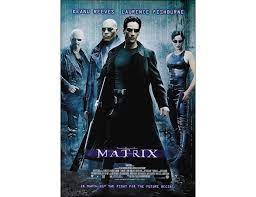
THE MATRIX
US, 1999, 136 minutes, Colour.
Keanu Reeves, Laurence Fishburne, Carrie-Anne Moss, Hugo Weaving, Gloria Foster, Joe Pantoliano, Belinda McClory, Paul Goddard, Robert Taylor.
Directed by the Wachowski Brothers/Lana Wachowski, Lilly Wachowski.
With the release of The Matrix in 1999, audiences both young and old responded to its exploration of the relationship between humans and modern technology. Philosophers around the world hurried to write articles for academic journals on how it raised the problems of what is real, what exists only in the mind and the possibilities of co-existing dimensions. Noted Catholic Polish director, Kzrystoff Zannussi, a member of the Vatican's Council for Culture was of the opinion that the film was a contemporary masterpiece and that people should see it, not only because of its extraordinary special effects but also because of its intellectual stimulus.
The Matrix offers a world where human-created computers and machines now hold the humans to ransom and who burrow through the earth to destroy them and their refuge city, Sion, can only be saved by Neo, an anagram of the One.
The Matrix trilogy introduced Neo as a Saviour-figure, someone human (or programmed like one) to be the means of saving the human race. In death and resurrection imagery, he was killed and then loved back to life by the warrior, Trinity. In Matrix Reloaded, the saviour role of Neo is developed but left in abeyance until Revolutions. By Matrix Revolutions, Neo is still the Saviour-figure par excellence, referred to by his enemy, Bane, as 'the blind messiah'. In apocalyptic imagery, with overtones of biblical battle imagery, he saves the bereft humans in the city of Sion and confronts the Satan-figure, Mr Smith, and is seen, arms outstretched as on a cross. His blinded eyes see an internal vision, glowing beauty, a kind of 'beatific vision' which culminates in his final apotheosis.
While the Wachowski Brothers drew on all kinds of popular sagas and mythology, their use of names with Christian-overtones for their characters as well as imagery that is familiar from biblical stories, mean that there can be fruitful dialogue between the movie and the scriptures.
The descent of Jesus into 'hell' or 'hades' or 'to the dead' is an article of the Apostles' and Nicene Creeds. Speculation in the early decades of the Church are echoed in references in Matthew's Gospel, the letter to the Ephesians as well as the suggested readings from John and I Peter. The tradition suggests that, while Jesus died for all, his death led him first to be associated with those who had gone before and were waiting to rise to new life with him.
The Jewish scriptures are full of battle imagery where God conquers the enemies of Israel as they do battle with their foes. It is useful to read chapters 38 and 39 of Ezekiel, the chapter of Armageddon, so beloved by fundamentalist and rapture Christians. Gog of Magog has a plan to destroy Israel but is no match for the power of God. God's warnings are given through the prophet. Perhaps the Wachowskis know Ezekiel. However, the machines are like Gog, overwhelming forces for destruction. The warriors of Sion are like the harassed people of Israel. Like Ezekiel, there is an Oracle who prophesies and guides, especially to lead the hero, Neo. These biblical battles provide a context for Jesus' descent to the Dead.
Since Neo is the saviour, he is pictured in Matrix Revolutions going down into his own 'hell'. He is betrayed by Bane, blinded by him. But his inner vision leads him to guide Trinity above the machines to a safe vision of clear and beautiful skies before he descends to do battle with Mr Smith. Part of his 'hell' is the sacrificial death of his beloved Trinity. As the power of megalomaniac Smith (Satanic in its delusions of grandeur) seems to conquer him, he goes into a grave before he regains the strength (with the images of Neo, arms outstretched) to finally defeat Smith.
Of course, many viewers will look at The Matrix trilogy as exciting science fiction or futuristic fantasy. Some will respond, according to producer, Joel Silver, just on the visceral level. Others will respond to the mythic layers. A Catholic response will explore those mythic levels and discover the links between the scriptures, Jesus of the Gospels and the religious symbols. For audiences who are not sure of their faith or their biblical knowledge, the films provide aspects of a new apologetics, a contemporary invitation to examine the credibility of the Catholic tradition.
Much of the production of The Matrix took place in Sydney. While Keanu Reeves had a strong reputation prior to this film and its sequels, it made him something of an icon. The film had a strong supporting cast led by Carrie Ann Moss and Laurence Fishburne who appeared in the later films. There is also an Australian cast, led strikingly by Hugo Weaving as the sinister, dark glasses-wearing, Agent Smith.
See the discussion material for the sequels, Matrix Reloaded, Matrix Revolutions and the 2021 Matrix Resurrections.